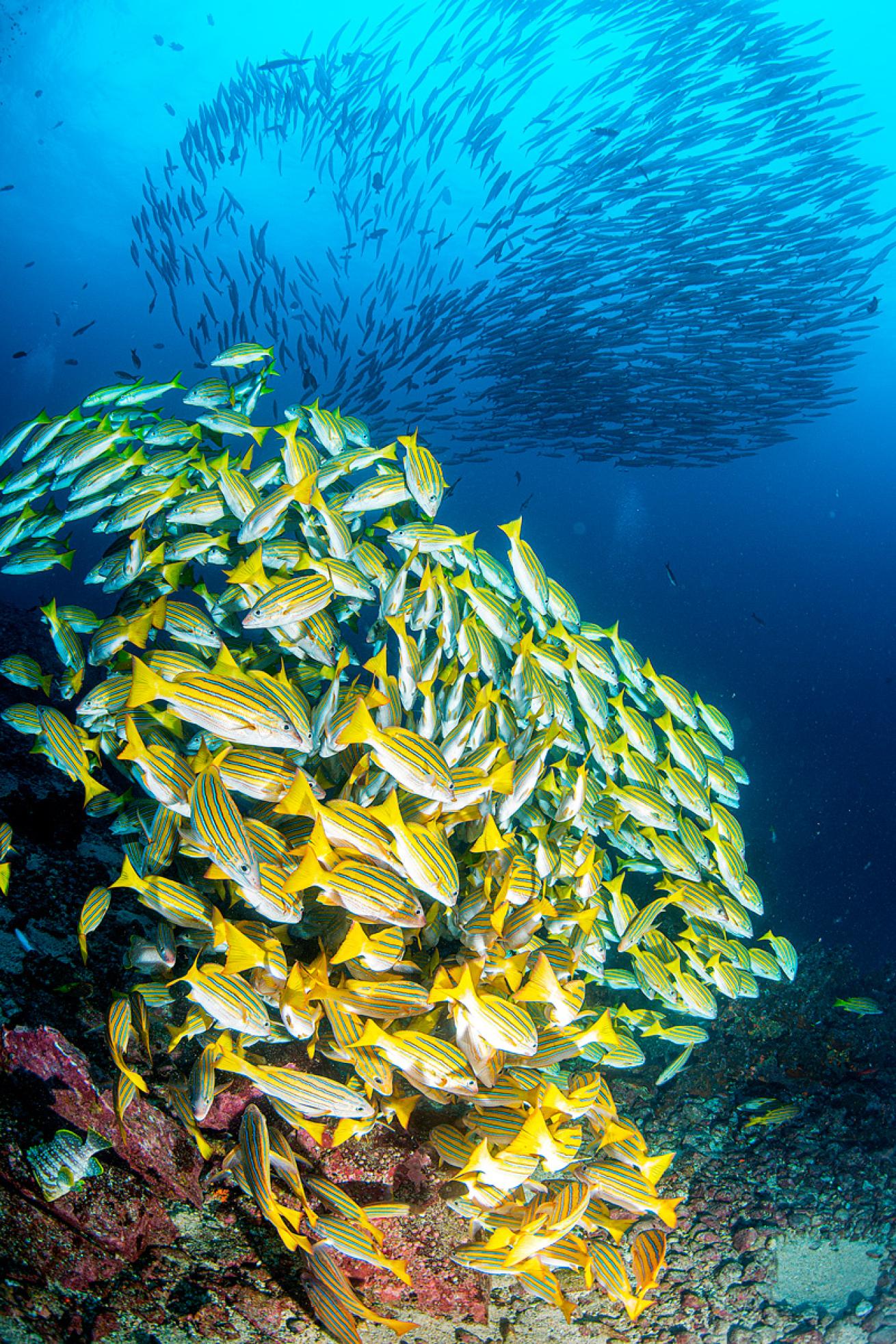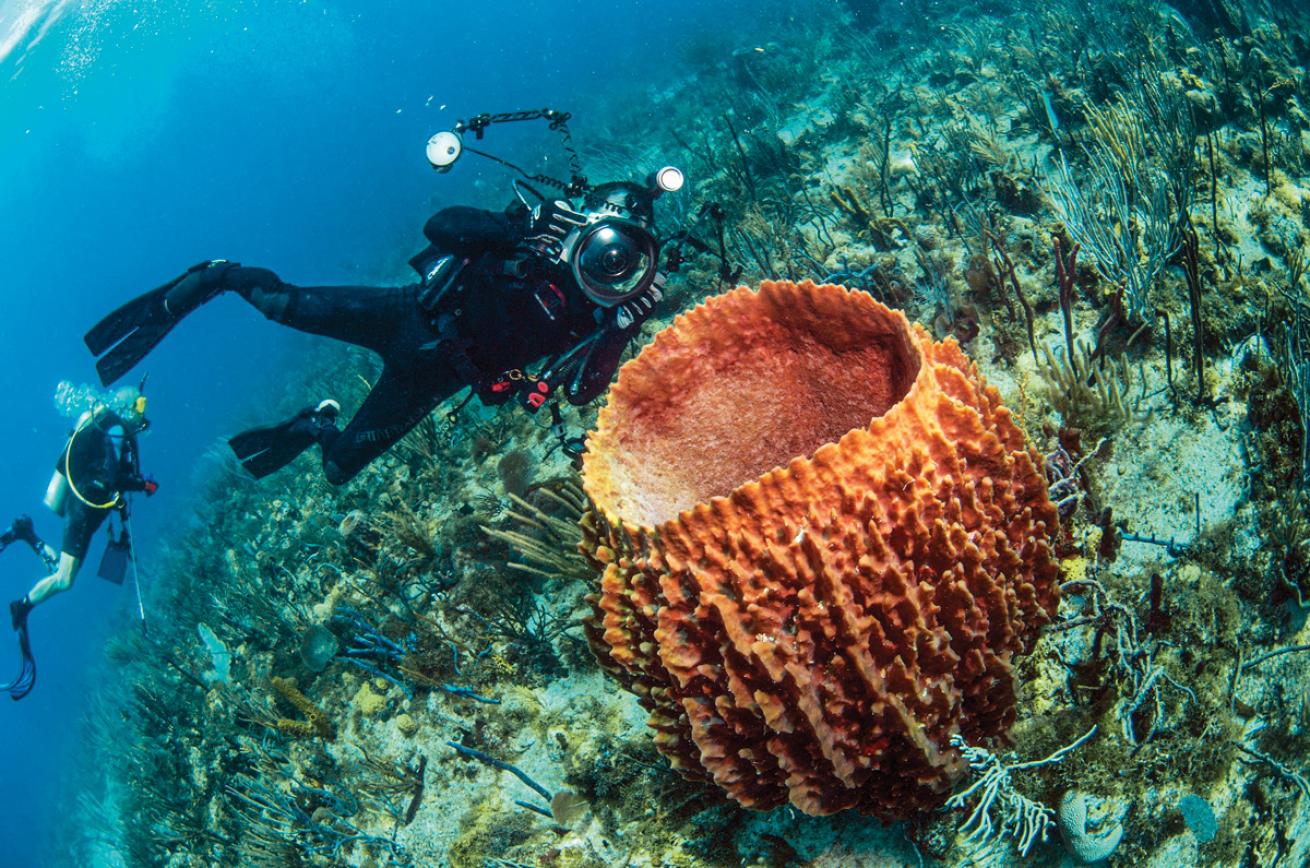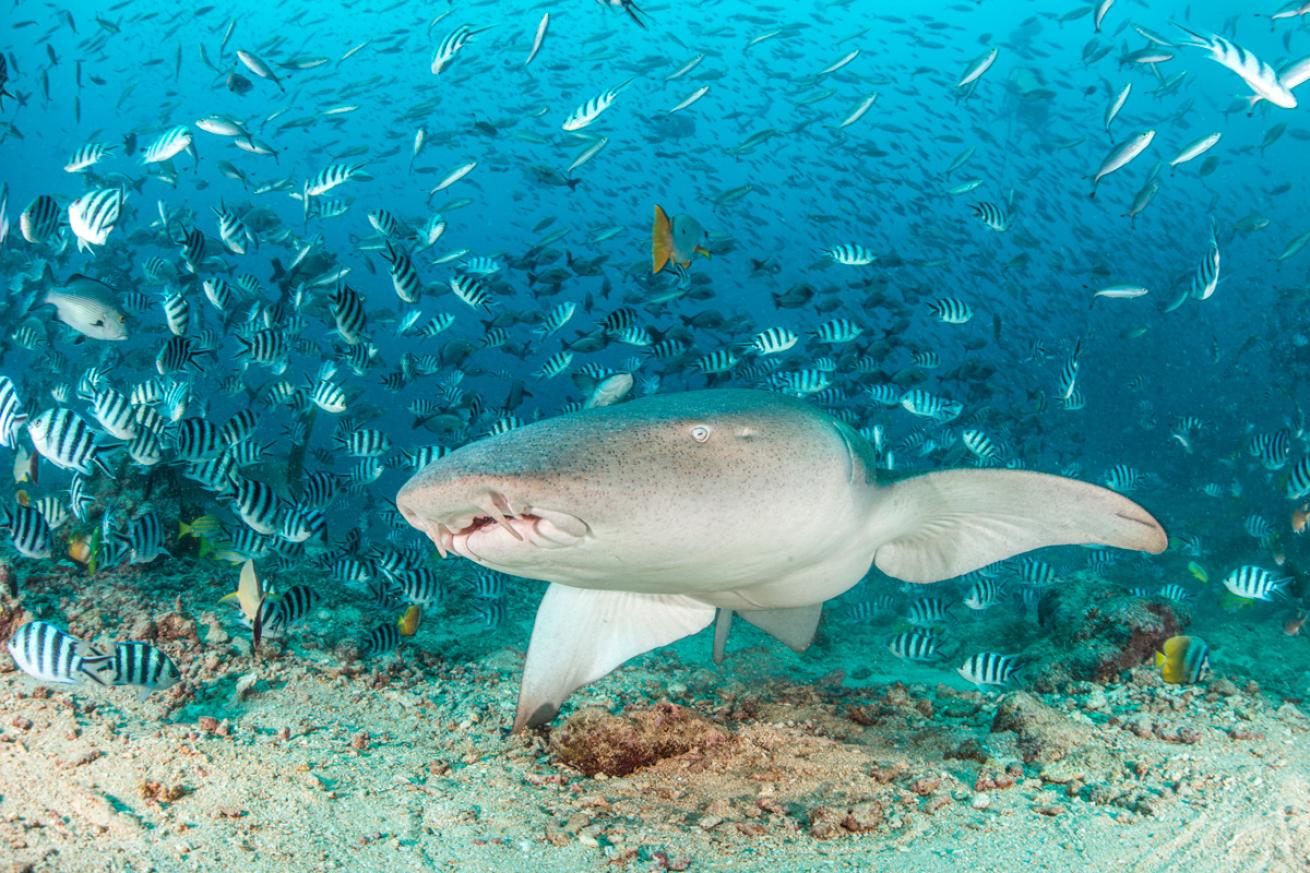Best Diving in Colombia, St. Kitts and Fiji
Planning a trip to one of these dive hotspots? Here’s what you need to know. Featuring insight from locals, tips for timing seasonal experiences, and the scoop on popular dive sites, as well as some lesser-known dives you’ll want on your radar too.

SHUTTERSTOCKFish school on a reef off the remote island of Malpelo.
Colombia
Under the Radar
Northern Colombia’s Tayrona National Natural Park is a hidden gem of diving in the southern Caribbean Sea, says Elisabeth Aichberger, of Ocean Lovers Dive Center in Taganga, Colombia. “It's very rich in healthy coral life, and all year round you can spot a great variety of marine life,” she says. “We observe magnificent corals that serve as a refuge for different species of invertebrates and vertebrates such as surgeonfish, grunts, wrasses, butterflyfish, parrotfish, octopuses, seahorses, flying gurnards, lobsters, eels and more.”
The Classic Dive
For most divers who dream of heading underwater in Colombia, Malpelo—a remote and pristine island roughly 300 miles west of the Colombian mainland—is legendary. “The sheer variety and abundance of marine life is truly staggering,” says Nicolás Filauri, of GaiaScuba. “You can expect to see everything from massive schools of hammerhead sharks and giant manta rays to curious sea turtles and much more.”
Currents can be strong, and the diving is geared toward experienced divers, he says. The rewards are many. “The island is surrounded by steep walls that drop off to dizzying depths, creating an otherworldly landscape that is simply unforgettable,” Filauri says.
Dive Report
Dive instructor Anthony Bonomi, of Oceano Scuba, has been wowed by the healthy reefs at Torin, Moto and Salidero, dive sites located within Tayrona National Natural Park. “We have some of the biggest brain corals I’ve ever seen, as well as massive sea fans and gardens of elkhorn corals,” he says. Dramatic topside views include sheer cliffs, cactus and green mountains. “From the bottom to the surface, it’s a dramatic and beautiful adventure that you can’t find anywhere else in the Caribbean,” Bonomi says.
Plan a Trip
From June to November, humpback whales arrive in the Pacific waters of Colombia, migrating from the chilly Antarctic to mate and give birth to their young. Look for males breaching and slapping their tails and females frolicking with their calves. The sounds of whale song are often heard during dives too.
Second-Time Visitor
Gorgona Island, a hotspot for seeing humpbacks during season, is another less visited locale worthy of a return trip to Colombia if you missed it your first time. “It's the perfect destination for divers who want to explore vibrant coral reefs and see tropical fish, sea turtles and even pelagic species like whale sharks and rays,” Filauri says.
Related Reading: How Intelligent Are Octopuses? Your Octopus Questions, Answered.

SHUTTERSTOCKA diver snaps a shot of a barrel sponge off St. Kitts.
St. Kitts
Under the Radar
Terry Crookes, of Pro Divers St. Kitts, says a thermal phenomenon at the site called the Vents—where you can feel warm water coming up from the bottom of a crater in the seafloor—makes for an interesting dive where fresh water and ocean water mix. The dive site’s abundant marine life includes large barrel sponges and soft corals populated by trunkfish, drum, moray eels, soldierfish, coral crabs and many other creatures.
The Classic Dive
When it comes to reefs, Crookes says divers love Brimstone Shallows, an extensive system 2 miles off shore with multiple dive sites to explore. Larger fish like horse-eye jacks, green morays and schools of creole wrasse abound. “The main attractions on this reef are the Caribbean gray reef sharks,” Crookes says. “They calmly swim around and sometimes through a group of divers, almost posing for photographs.”
Dive Report
“Since the start of 2023 we’ve enjoyed the presence of a lone wild bottlenose dolphin,” says Crookes. “This dolphin has been interacting with divers and is becoming accustomed to playing with them. It’s also been seen interacting with snorkelers in Frigate Bay.”
Plan a Trip
Leatherback turtle nesting season on the beaches of St. Kitts and Nevis starts in April and lasts through June, when you might also spot them in the islands’ waters. And visit St. Kitts during the summer months, considered the off season, for lower hotel rates and quiet beaches. “The summer months are great for diving,” Crookes says. “There are calm seas, no current, and water temperatures hover over 80 degrees.”
Second-Time Visitor
Stock your home liquor cabinet with something special during a visit to the historic rum distillery Old Road Rum Company at Wingfield Estate in St. Kitts, where tastings and tours make for a fun and educational activity once the diving day is done. Parts of the site date to 1681, making it the oldest surviving distillery of its kind in the Caribbean. “It’s one of the smaller attractions in St. Kitts and not really on the tourist map yet,” Crookes says.
Related Reading: Red Sea Research Indicates Dolphins Use Corals for Skincare

GERALD NOWAKA nurse shark prowls an outer reef at a dive site in Fiji.
Fiji
Under the Radar
“People don’t often think of Fiji when talking wrecks, but Beqa Lagoon has the largest collection of wrecks in Fiji,” says Brandon Paige, of Beqa Lagoon Resort, best known for its shark dives. The seven wrecks you can dive within the lagoon include Taiwanese longliner fishing vessels that were purpose-sunk to form incredible artificial reefs. Most of the wrecks are upright and intact, Paige says, and big enough to be penetrated. “The fish life is really great too, with mostly juveniles,” he says.
The Classic Dive
The classic Fiji dive usually involves sharks of one variety or another, abundant in these waters. For guests at Beqa Lagoon Resort, Cathedral Cove is the only dive in Fiji where you are pretty much guaranteed to see tiger sharks on every shark dive day, Paige says. Guests at VOMO Island Fiji look forward to shark dives in the Yasawa Islands. "Expert divers feed the sharks, ensuring they are well fed, and therefore they are completely disinterested in the divers watching on,” says the resort’s dive center manager, Ornella J. Lee.
Dive Report
Paige says tiger shark season is off to a great start in Beqa Lagoon. “We average seeing around two or three tiger sharks per dive, plus bull, nurse and lemon sharks.”
Related Reading: Fiji After Dark: One Diver’s Journey Into Night Diving
Plan a Trip
Manta rays make their way south into Fiji’s waters between May and October, when they’re commonly seen around VOMO Island Fiji and the Yasawa Islands, Lee says. “The waters are a little cooler at this time but still lovely, with no need for a thick wetsuit, and they’re usually crystal clear due to weather conditions,” she says.
Second-Time Visitor
If you missed the chance to visit a local village school on your first trip to Fiji, ask your resort to help arrange a visit during a second stay. “Many people bring things with them to donate to the schools like books, pens, crayons and even school bags,” Paige says. All are much appreciated by people living in the remote corners of the world where divers often travel.










